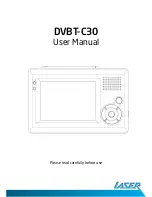
2.3.6 - Protection des paliers à roulements
Le palier peut être protégé contre l'échauffement par des
sondes CTP ou des sondes RTD (suivant le choix du
client). La température du palier doit être inférieure à
90
°
C.
Pour une utilisation spéciale dans une ambiante chaude,
si la température des paliers dépasse les limites (pour
un roulement reconnu en bon état) contacter l'usine.
En utilisation standard (température ambiante inférieure
à 45
°
C), si la température des roulements dépasse la li-
mite acceptable, il est nécessaire d'en rechercher les
causes.
2.4 - Boite à bornes
2.4.1 - Description de la boite à bornes
La boite à bornes principale de l'alternateur est située au
dessus de la machine.
Les câbles de neutre et de phases sont connectés sur
des barres, une barre par phase et une barre par ligne
de neutre.
Les ouvertures donnent accès aux bornes.
Les plaques presse étoupe sont faites en matériaux non
magnétiques pour éviter les courant de circulation.
Le branchement des accessoires se fait sur borniers.
2.4.2 - Système d'excitation/régulation
Se référer au manuel du régulateur et au paragraphe 3
de cette notice.
2.4.3 - Régulateur automatique de tension
Lorsque le régulateur automatique de tension est situé
dans la boite à bornes celui-ci est isolé des vibrations
par l'intermédiaire de tampons amortisseurs
2.5 - Protections
2.5.1 - Sondes de protection stator
Voir "protection du stator" dans le chapitre STATOR,
Chapitre 2.1.6.
2.5.2 - Protection des paliers
Voir "protection des paliers" dans le chapitre PALIER,
Chapitre 2.3.6.
2.6 - Plaques signalétiques
a) Plaque signalétique principale
La plaque signalétique principale est fixée sur le stator.
Elle indique les caractéristiques électriques, le type et le
numéro de série de la machine.
Pour les machines à paliers à roulements, le volume de
graisse, le type et la périodicité de graissage sont indi-
qués sur cette plaque signalétique.
b) Plaque sens de rotation
Une flèche est fixée à l'avant du palier pour donner le
sens de rotation.
10
Alternators
LSA 50-51
Alternateurs
LSA 50-51
2.3.6 - Bearing protection devices
The bearing may be protected from over-heating by PTC
or RTD sensors (depending on the customer's choice).
The bearing operating temperature must be less than
90
°
C.
For special use in warm surroundings, if the temperature
of the bearings exceeds the authorised limit (for a bear-
ing known to be in good condition), contact the factory.
Under normal operating conditions (ambient temperature
less than 45
°
C), if the temperature of the bearings ex-
ceeds the authorised limit, it is necessary to find out why
this is occurring.
2.4 - Terminal box
2.4.1 - Description
The main terminal box of the alternator is located on the
top of the machine.
The neutral and phase wires are connected to the bars,
one bar per phase and one bar per neutral line.
The openings provide access to the terminals.
The packing-box plates are made of non-magnetic mate-
rials in order to avoid circulating currents.
The connection of accessories is carried out on terminal
strips. Use a 5 mm maximum screwdriver to work on the
blocking screws.
2.4.2 - Excitation/regulation system
Refer to the regulator instruction manual and to para-
graph 3 of this manual.
2.4.3 - Automatic voltage regulator
When the automatic voltage regulator is located in the
terminal box, it is insulated from vibrations through
means of dampening pads.
2.5 - Protection devices
2.5.1 - Stator protection sensors
See "stator protection" in the STATOR chapter (Chap.
2.1.3).
2.5.2 - Bearing protection devices
See "bearing protection" in the BEARING chapter (Chap.
2.3.6).
2.6 - Nameplate
a) Main nameplate
The main nameplate is fitted to the stator. It gives the
manufacturer's electrical characteristics, the type and se-
rial numberof the machine.
For machines with roller bearings, the quantity of grease,
the type and frequency of lubrication are stipulated on
this nameplate.
b) Rotation direction nameplate
An arrow is fitted to the bearing to indicate the rotation
direction.











































